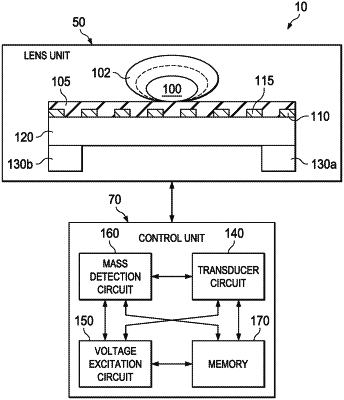| CPC G02B 27/0006 (2013.01) [B08B 7/028 (2013.01); G01H 13/00 (2013.01); G01D 5/2405 (2013.01)] | 15 Claims |

|
1. An apparatus, comprising:
a lens having a surface with electrodes;
a mass detection circuit coupled to the surface of the lens, wherein the mass detection circuit is configured to detect a first droplet present on the surface, and calculate a mass of the first droplet by measuring a change in capacitance between a consecutive pair of electrodes;
a transducer circuit coupled to the surface, wherein the transducer circuit is configured to excite a first vibration of the surface at a resonant frequency to form a high displacement region on the surface, wherein the transducer and the surface form a lens unit;
a voltage excitation circuit coupled to the electrodes and configured to detect the location of the first droplet, wherein in response to the calculation of the mass and location of the first droplet, the voltage excitation circuit is configured to apply a sequence of differential voltages on one or more consecutive electrodes to move the first droplet to the high displacement region; and
a memory circuit coupled to the transducer circuit, the mass detection circuit, and the voltage excitation circuit.
|